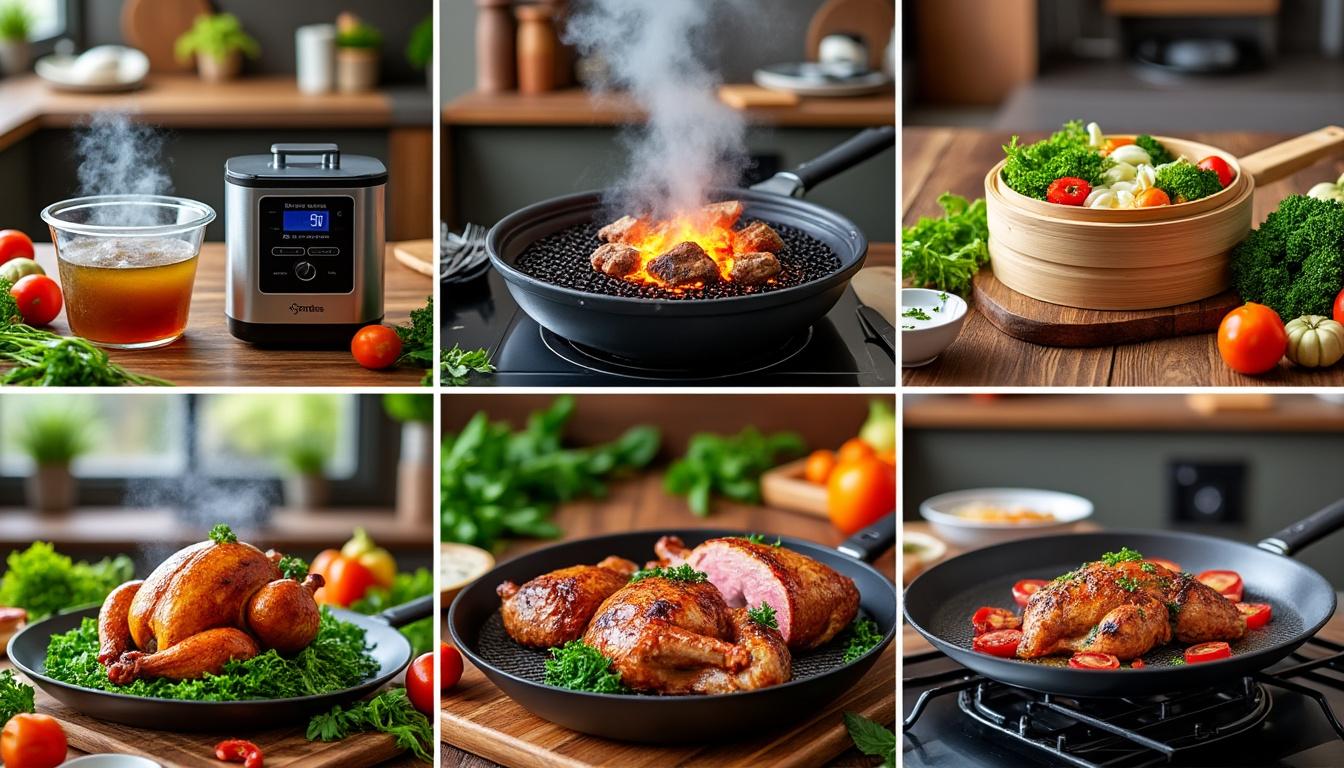Cooking techniques compared: concise guide to grilling, sous vide, braising and searing, which cooking techniques deliver restaurant-quality results at home.
Exploring the most effective cooking techniques for home and professional kitchens, this piece examines precision methods, high-heat finishes and slow, flavor-building approaches. The analysis draws on testing traditions from America’s Test Kitchen, recipe labs like Serious Eats and editorial insight from Bon Appetit and Epicurious. Expect practical tips, technique trade-offs and links to hands-on guides for cooks at every level.
Cooking Techniques: Precision Methods — Sous Vide, Poaching and Low-Temp Control
Precision-focused cooking techniques prioritize consistency and texture. Sous vide has transformed how chefs control doneness, while gentle poaching preserves delicate proteins and flavors. The science behind these methods appears in sources such as ChefSteps and testing notes from America’s Test Kitchen.
- Sous vide: precise temperature control for consistent results.
- Poaching: ideal for eggs, fish and delicate fruits.
- Low-temp roasting: tenderizes connective tissue without overcooking.
Examples: a small catering startup used sous vide to standardize portion cooking; a neighborhood bistro relied on poaching to preserve bright citrus profiles in fish entrees. For practical at-home steps, consult the tutorial on standard techniques and timing at culinary lessons for everyday cooking.
Key insight: for repeatable tenderness and minimal risk of overcooking, precision cooking techniques often outperform rapid high-heat alternatives in consistency.
Cooking Techniques: High-Heat Methods — Grilling, Pan-Searing and Broiling
High-heat cooking techniques create flavor through the Maillard reaction and caramelization. Grilling and pan-searing add crust and aroma; broiling brings intense top-down heat. These methods are staples in videos from Food Network and viral demos on Tasty.
- Grilling: ideal for smoke and char—pair with high-fat cuts for best results.
- Pan-searing: quick, controllable crust; finish in oven if needed.
- Broiling: fastest way to add a crisp top to vegetables and proteins.
Practical note: many chefs combine approaches—start with sous vide for even doneness, then finish with a sear for texture. For searing tips inspired by burger masters, see the practical guide on smashburger technique at George Motz smashburger tips. For oil choices and heat tolerance when using these techniques, review the analysis at olive oil and high temperatures.
| Technique | Best Uses | Pros | Cons |
|---|---|---|---|
| Sous Vide | Steak, eggs, seafood | Precision, consistent doneness | Time-consuming, needs equipment |
| Pan-Sear | Steak, fish, vegetables | Fast crust, accessible | Risk of uneven cooking for thick cuts |
| Grilling | Large cuts, vegetables | Smoky flavor, high heat | Weather-dependent, flare-ups |
| Braising | Tough cuts, stews | Deep flavor, tenderizes | Long cook times |
Key insight: selecting among cooking techniques hinges on ingredient structure—fat content, thickness and connective tissue determine whether high heat or gentle moisture will best elevate flavor.
Cooking Techniques: Moist Heat and Slow Methods — Braising, Steaming and Fermentation
Moist-heat cooking techniques unlock tenderness and complex flavors over time. Braising breaks down collagen into gelatin; steaming preserves nutrients and texture. These methods are central to traditions featured by BBC Good Food and recipe platforms like Allrecipes.
- Braising: low-and-slow for rich, fork-tender results.
- Steaming: retains color and nutrients for vegetables and dumplings.
- Fermentation: not a cooking step but complements techniques by building depth.
Practical resources: compare slow-cook method outcomes and how diet-focused approaches impact flavor and health at diet cooking and brain health. For quick culinary hacks to improve texture and timing, see culinary hacks for cooking skills.
Key insight: when time and collagen are allies, choose slow cooking techniques like braising to transform economical cuts into signature dishes.
Practical Cross-Method Tips and Source References
Blending methods often yields the best results: precision sous vide followed by a high-heat sear or a brief broil. Trusted recipe sources such as Martha Stewart, Epicurious and feature testing at Serious Eats can guide timings and finish techniques.
- Plan: match method to ingredient structure and desired texture.
- Test: follow measured temps and times; see practical examples at cooking techniques and lipid profiles.
- Refine: use small trials to adjust seasoning and finish.
For seasonal ingredient pairing and chef-recommended pantry items, review the curated list at chef’s guide to may ingredients and practical recipe compilations at chefs’ ultimate pasta recipes. Also explore inspiration and voice from Tasty and recipe testing on Allrecipes.
Key insight: method hybridization lets cooks control both texture and flavor; modern kitchens benefit from integrating classical cooking techniques with tested shortcuts.
Practical Exercises to Master Core Cooking Techniques
Hands-on practice accelerates skill acquisition. Use structured exercises—from searing thin cuts to controlled sous vide runs—to internalize time-temperature relationships. Community and workshop resources, including local classes and online series, complement self-testing.
- Exercise 1: sous vide salmon at 50°C for 30 minutes, then quick sear.
- Exercise 2: reverse-sear a thick steak—oven then hot pan finish.
- Exercise 3: braise short ribs at low temperature for 3–4 hours and compare textures.
Further reading and step-by-step guides appear in practical tests like Inner Chef home cooking and technique breakdowns at cooking tips from practitioners.
Key insight: structured repetition builds intuitive control over heat and timing, making advanced cooking techniques accessible to home cooks.
Common Questions About Cooking Techniques
How do I choose between sous vide and pan-searing for steak?
Choose sous vide when consistent doneness is the priority; combine with a high-heat pan-sear to add crust. For time-sensitive meals, prefer searing with careful monitoring.
Are high-heat methods healthier than low-temp techniques?
Health depends on factors like oil choice and doneness. Low-temp methods often preserve nutrients; high-heat methods enhance flavor but require proper oils—see testing on olive oil heat tolerance.
Which technique saves the most time for weeknight cooking?
Quick high-heat methods like pan-searing or broiling are fastest. For consistent results with minimal active time, prep with sous vide ahead and finish quickly when needed.
Can mastering a few techniques replace a large recipe library?
Yes—mastering core cooking techniques (searing, braising, steaming, sous vide) enables improvisation across cuisines and reduces reliance on strict recipes.

